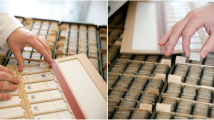Abstract
A history of the herbarium of the cocoa research center, located in the cocoa-producing region of southern Bahia, Brazil, is provided. The history includes geographic references to important collecting localities, descriptions of the vegetation types from which collections have been made, an annotated list of collectors who have worked in the region since 1965, and a summary of the activities of the herbarium. Maps of collecting localities and vegetation types of the region are also included.
Similar content being viewed by others
Literature Cited
Alvim, P. de T. 1950. ObservaÇÕes ecológicas sobre a flora da regiÃo semi-→ida do nordeste. Bol. Geogr. 7(85): 75–82.
—. 1954. Teoria sobre a formaÇ⊸ dos campos cerrados. Revista Brasil. Geogr. 16: 96–98.
Barroso, G. M. & S. G. da Vinha. 1970.Stifftia axillaris, uma nova espécie de Compositae. Loefgrénia 44: 1.
Ettinger, A. E. de M., A. M. F. de Carvalho, M. H. Alencar, C. P. Pereira & S. R. Asmar. 1977. Diagnóstico técnico-econÔmico do desenvolvimento da pecuária das regiÕes sul e sudoeste da Bahia. CEPLAC & SUDENE, Ilhéus, Bahia, Brazil.
Fowler, R. L. & P. de T. Alvim. 1977. CEPLAC, twenty years of technical assistance to cacao in Brazil. DICOM, Executive Commission for the Cacao Development Plan. Itabuna, Bahia, Brazil.
GouvÊa, J. B. S., L. A. Mattos Silva & M. Hori. 1976. 1. Fitogeografia. Pp. 1–7.In: Diagnóstico SocioeconÔmico da RegiÃo Cacaueira, Recursos Florestais, vol. 7. ComissÃo Executiva do Piano da Lavoura Cacaueira and the Instituto Interamericano de CiÊncias Agricolas-OEA. Ilhéus, Bahia, Brazil.
Holmgren, P. K. & W. Keuken. 1974. Index Herbariorum. Part I. The herbaria of the world, ed. 6. Regnum Veg. 92.
—. 1976. Additions to “The herbaria of the world.” Taxon 25: 517–524.
—. 1977. Additions to “The herbaria of the world” ed. 6 (II). Taxon 26: 483–491.
—. 1978. Additions to “Herbaria of the world” ed. 6 (III). Taxon 27: 427–432.
Instituto Brasileiro de Geografia. 1972. Carta do Brasil ao milionésimo. Ministério do Planejamento e CoordenaÇÃo Gérai, FundaÇÃo IBGE, Instituto Brasileiro de Geografia. Rio de Janeiro.
Joly, A. B. 1970. ConheÇa a vegetaÇÃo Brasileira. Ed. Univ. de SÃo Paulo e Polígono. SÃo Paulo.
LeÃo, A. C. & S. G. de Vinha. 1975. OcorrÊncia do Jacarandá no sul da Bahia. Cacau Atualidades 12(4): 22–29.
Lima, Dárdano de A. 1954. Contribution to the study of the flora of Pernambuco, Brazil. Universidade Rural de Pernambuco, Monografia I.
—. 1966. VegetaÇâo.In: Conselho Nacional de Geografia. Atlas Nacional do Brasil. Instituto Brasileiro de Geografia. Rio de Janeiro.
Nascentes, A. 1971. Indice dos topÔnimos da carta do Brasil ao milionésimo. Ministério do Planejamento e CoordenaÇÃo Gℰai, FundaÇâo IBGE, Instituto Brasileiro de Geografia, Departamento de Cartografia. Rio de Janeiro.
Oliveira, E. 1978. RondÔnia-um irreversível pólo cacaueiro. Cadernos da AmazÔnia-1. DICOM, ComissÃo Executiva do Piano da Lavoura Cacaueira. Itabuna, Bahia, Brazil.
Rosário, M., T. Perrucho, R. L. Fowler & J. C. de Sales. 1978. CACAU história e evoluÇÃo no Brasil e no mundo. DICOM, Comis~ao Executiva do Piano da Lavoura Cacaueira. Ilhéus, Bahia, Brazil.
Veloso, H. P. 1965. ContribuiÇÃo à fitogeografia do Brasil. Anuário Brasil. Econ. Florest. 17: 123–134.
Vinha, S. G. da. 1973. Novas Melastomataceae encontradas na regiÃo sul da Bahia. Bradea 1: 319–323.
—, T. de Jesus Soares Ramos & M. Hori. 1976a. 2. Inventário Florestal. Pp. 20–212.In: Diagnóstico SocioeconÔmico da RegiÃo Cacaueira, Recursos Florestais, vol. 7. ComissÃo Executiva do Piano da Lavoura Cacaueira and the Instituto Interamericano de CiÊncias Agrícolas-OEA. Ilhéus, Bahia, Brazil.
—. 1976b. 3. Principals vegetais Úteis. Pp. 213–246.In: Diagnóstico SocioeconÔmico da RegiÃo Cacaueira, Recursos Florestais, vol. 7. ComissÃo Executiva do Piano da Lavoura Cacaueira and the Instituto Interamericano de CiÊncias Agrícolas-OEA. Ilhéus, Bahia, Brazil.
Whitney, P. D. 1977. The cocoa market in Brazil: an analysis. Department of State of the United States, unclassified information.
Author information
Authors and Affiliations
Rights and permissions
About this article
Cite this article
Mori, S.A., Silva, L.A.M. The herbarium of the “Centro de Pesquisas do Cacau” at Itabuna, Brazil. Brittonia 31, 177–196 (1979). https://doi.org/10.2307/2806174
Issue Date:
DOI: https://doi.org/10.2307/2806174




